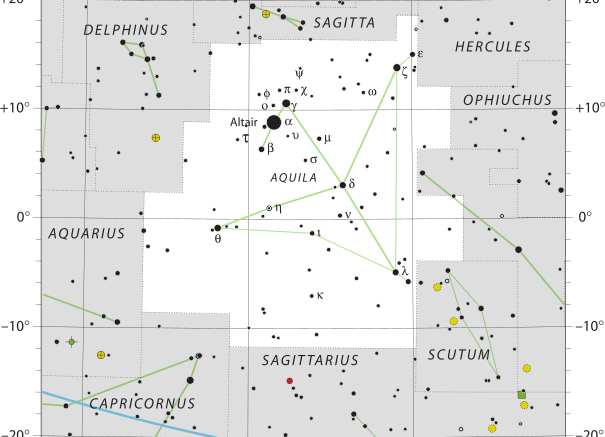Aquila is a constellation on the celestial equator, with a Latin name meaning ‘Eagle’. Aquila represents the bird that carried Zeus/Jupiter’s thunderbolts in Greek-Roman mythology.
Its brightest star, Altair, is one vertex of the Summer Triangle asterism. The constellation is best seen in the northern summer, as it is located along the Milky Way. Because of this location, many clusters and nebulae are found within its borders, but they are dim and galaxies are few.
| Applicable Information | |
| Visibility In Pacific Northwest | May to October |
| Best Times To View | June, July, and August |
| Right Ascension | 18h 41m 18.2958s– 20h 38m 23.7231s |
| Declination | 18.6882229°–−11.8664360° |
| Area | 652 square degrees |
| Main Stars | 3 |
| Brightest Object | Altair (0.76m) |
| Meteor showers | June Aquilids and Epsilon Aquilids |
| Messier objects | 0 |
| Neighboring Constellations | Sagitta, Hercules, Ophiuchus, Serpens Cauda, Scutum, Sagittarius, Capricornus, Aquarius, Delphinus |
The Name
1 of the 88 modern constellations defined by the IAU, Aquila was one of the 48 constellations described by the second-century astronomer Ptolemy. Ptolemy wasn’t the first to mention Aquila, as Eudoxus in the fourth century BC and Aratus in the third century BC made notice of the constellation
For Romans, the constellation was known as Vultur volans, which translates to ‘the flying vulture’ in Latin. It is often held to represent the eagle which held Zeus’s/Jupiter’s thunderbolts in Greco-Roman mythology. Aquila is also associated with the eagle that kidnapped Ganymede, a son of one of the kings of Troy, to Mount Olympus to serve as cup-bearer to the gods.[1]
The Greek Aquila is probably based on the Babylonian constellation of the Eagle, but is sometimes mistakenly thought as a seagull which is located in the same area as the Greek constellation.[2]
Stars
The brightest star in the constellation is Altair, which is the 12th brightest star in the sky.
There are no messier objects to be found in this constellation.
Aquila contains eight named stars, which have been officially approved by the International Astronomical Union. These eight named stars are named Alshain, Altair, Chechia, Libertas, Okab, Petra, Phoenicia, and Tarazed.
Make sure to check out other articles on the site, including a brief introduction to constellations, other constellation articles, and more!
Sources
[1] = Ridpath, Ian (2001), Stars and Planets, Illustrated by Wil Tirion (3rd ed.), Princeton University Press, ISBN 0-691-08913-2
[2] = White, Gavin (2008), Babylonian Star-lore, Solaria Pubs

Be the first to comment on "Aquila"